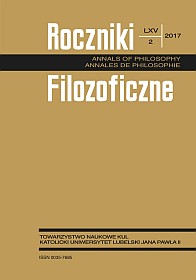The Leibnizian Doctrine of vinculum substantiale and the Problem of Composite Substances
Abstrakt
Leibnizjańska koncepcja vinculum substantiale a problem substancji złożonych
Artykuł poświęcony jest późnej Leibnizjańskiej koncepcji vinculum substantiale. W paragrafie 1 zarysowuję stary problem możliwości substancji złożonych. Jest ona odrzucona na gruncie Monadyzmu, któremu poświęcam paragraf 2. Niemniej w korespondencji Leibniza z Des Bossesem pojawiają się nowe myśli dotyczące substancji złożonych. Na scenę wchodzi vinculum substantiale, czyli realna zasada jedności, przetwarzająca agregaty monad w prawdziwe substancje (paragraf 3). W ostatniej części dostarczam systematycznej interpretacji vinculum.
Zaczynam od tezy, że każda rzeczy złożona, która nie jest czystą mnogością przedmiotów, musi mieć dwie struktury: strukturę całość–części i strukturę podmiot–własności. W przypadku substancji ta druga jest ontycznie nadrzędna nad pierwszą. Vinculum jest podmiotem-własności (przypadłości), wyznaczającym taki sposób kompozycji, który czyni złożoną rzecz substancją. Ponieważ Leibniz ciągle uważał, że vinculum jednoczy niezależne (egzystencjalnie i co do działania) substancje, był skłonny oddzielać vinculum od zjednoczonych monad i ostatecznie pojął vinculum jako dodatkową, względnie niezależną substancję.
Bibliografia
Cover, Jan Arthur, and John Hawthorne. 1999. Substance and Individuation in Leibniz. Cambridge: Cambridge University Press.
Ingarden, Roman. 1965. Der Streit um die Existenz der Welt. Band II/1. Tübingen: Max Niemeyer Verlag.
Leibniz, Gottfried Wilhelm. 1989a. “A New System of the Nature and the Communication of Substances, as well as the Union Between the Soul and the Body.” Translated by Leroy E. Loemker. In Gottfried Wilhelm Leibniz. Philosophical Papers and Letters, edited by Leroy E. Loemker, 453–461. Dordrecht, Boston,London: Kluwer.
Leibniz, Gottfried Wilhelm. 1989b. “Monadology.” Translated by Leroy E. Loemker. In Gottfried Wilhelm Leibniz. Philosophical Papers and Letters, edited by Leroy E. Loemker, 643–653. Dordrecht, Boston, London: Kluwer.
Leibniz, Gottfried Wilhelm. 2007. The Leibniz–Des Bosses Correspondence. Translated by Brandon C. Look and Donald Rutherford. New Heaven, London: Yale University Press.
Look, Brandon C. 2000), “Leibniz and the Substance of the Vinculum Substantiale”, Journal of the History of Philosophy 38/2: 203–220.
Look, Brandon C., and Donald Rutherford. 2007. Introduction to Gottfried Wilhelm Leibniz. The Leibniz–Des Bosses Correspondence. Translated by Brandon C. Look and Donald Rutherford, xix-lxxix. New Heaven, London: Yale University Press.
Piwowarczyk, Marek. 2016. “A Leibnizian Inspiration: The Nomological Model of the Subject-Properties Structure.” In “Für unser Glück oder das Glück anderer”: Vorträge des X. Internationalen Leibniz-Kongresses, Hannover, 18.-23. Juli 2016. Band 4, edited by Wenchao Li, 301–311. Hildsheim: Georg Olms Verlag
Rosiak, Marek. 2001. “Własności relacyjne, całości i przedmioty wyższego rzędu [Relational Properties, Wholes and Objects of Higher Order].” Principia, vol. 30: 117-133.
Rosiak, Marek. 2006. “Formal and Existential Analysis of Subject and Properties.” In Essays in Logic and Ontology, edited by Jacek Malinowski and Andrzej Pietruszczak, 285–299. Amsterdam, New York: Rodopi.
Copyright (c) 2017 Roczniki Filozoficzne

Utwór dostępny jest na licencji Creative Commons Uznanie autorstwa – Użycie niekomercyjne – Bez utworów zależnych 4.0 Międzynarodowe.





